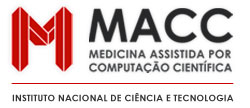About the ADAN Model The ADAN Model was developed by Prof. Mário Sansuke Maranhão Watanabe as a part of his PhD thesis at the National Laboratory of Scientific Computing (LNCC/MCTI), 2013, being advisored by Prof. Pablo J. Blanco and Prof. Raúl A. Feijóo. This model was developed in order to attend one of the major R&D objectives (namely Computational Modeling and Simulation of the Human Cardiovascular System) at the National Institute of Science and Technology in Medicine Assisted by Scientific Computing (INCT-MACC, coordinated by Prof. Raúl A. Feijóo) and at the Hemodynamic Modeling Laboratory (HeMoLab/LNCC, an associated laboratory of the INCT-MACC, founded by Prof. Raúl A. Feijóo and now coordinated by Prof. Pablo J. Blanco). The ADAN model is a computational model of the human arterial system provided with an unprecedented anatomical fidelity aimed at simulating blood flow phenomena. This model is stands out on two main points: (1) the complexity of the arterial network on top of which a one-dimensional mathematical model is used to perform blood flow simulations and (2) the boundary conditions of the one-dimensional model for which criteria and specific methodologies were developed to define and impose a given blood flow distribution. With regard to arterial topology , the ADAN Model comprises almost all arteries reported in the medical literature (see for example F.H. Netter, Atlas of Human Anatomy, Elsevier, 5th edition, 2011, W. Dauber, Pocket Atlas of Human Anatomy by H. Feneis, Thieme, 5th edition, 2007 and K. Moore et. al., Clinically Oriented Anatomy, Wolters Kluwer, 6th edition, 2010, among others). In other words, this is the most complete human arterial model developed up to date for blood flow computational simulation. The ADAN Model includes 2142 vessels from the vasculatures of the head, trunk, limbs, abdominal organs, brain and heart. The blood flow is modeled as flow of an incompressible fluid through compliant vessels. The level of description has been pushed down to the level of perforator arteries, which can be regarded as the pre-arteriolar level of the vasculature. A one-dimensional approximation of the Navier-Stokes equations is adopted to describe the blood flow rate and pressure throughout the arterial tree in a distributed way. In order to deal with the boundaries conditions at the end points where the network was truncated, an innovative approach based on the Vascular Territories Theory was developed taking into account stringent physiological and anatomical criteria. Moreover, an algorithm for identification of vascular territories resistances was also developed to calibrate Windkessel terminal models such that a certain flow distribution was imposed. Hence, the ADAN Model is capable of providing insight about the hemodynamic environment in vascular segments and regions that current existing models do not reach. Moreover, the ADAN Model provides an extensive morphometric database of the human arterial tree which resulted from the exhaustive search for geometrical and mechanical parameters in the existing specialized literature. The ADAN Model can be used by medical doctors, physiologists, biomedical engineers and cardiovascular researchers as a computational hemodynamic laboratory of the entire human arterial tree. Furthermore, it can be used as a tool to be explored for medical educational purposes. In this respect, the following institutions have been collaborated in the development of the ADAN Model.
Finally more information about the model is found in the following publications (see also the HeMoLab web page at http://hemolab.lncc.br/):
|
||
|
HeMoLab - Hemodynamic Modeling Laboratory, http://hemolab.lncc.br/ |
LNCC/MCTI - National Laboratory of Scientific Computing, http://www.lncc.br/ |
|


